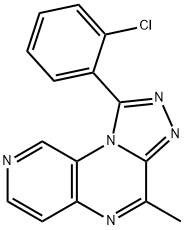1426833-08-0
 1426833-08-0 結構式
1426833-08-0 結構式
基本信息
Pyrido[4,3-e][1,2,4]triazolo[4,3-a]pyrazine, 1-(2-chlorophenyl)-4-methyl-
物理化學性質
常見問題列表
|
hPDE2A 29 nM (IC 50 ) |
rPDE10A 480 nM (IC 50 ) |
hPDE4D 5890 nM (IC 50 ) |
hPDE11A 6920 nM (IC 50 ) |
PDE2/PDE10-IN-1 (Compound 6) inhibits PDE2 and PDE10, respectively, with an IC 50 value of 29 and 480 nM. PDE2/PDE10-IN-1 also inhibits PDE11A and PDE4D with IC 50 s of 6920 nM and 5890 nM, respectively. In addition PDE2/PDE10-IN-1 does not show significant inhibition of a panel of CYP450 enzymes (CYP1A2, 2C9, 2D6, 2C19, and 3A4). PDE2/PDE10-IN-1 is also inactive up to a concentration of 125 μg/mL in a bacterial mutagenicity assay.
The PK properties of PDE2/PDE10-IN-1 are studied in rats after 2.5 mg/kg i.v. and 10 mg/kg p.o. administration. After i.v. administration, a rapid clearance is observed (t 1/2 =0.47 h), which is not expected based on the in vitro metabolic stability in rat liver microsomes (rLMs). Interestingly, PDE2/PDE10-IN-1 shows much slower clearance after p.o. administration (t 1/2 =2.36 h), resulting in good bioavailability and a maximum plasma concentration (C max ) of 997 ng/mL. PDE2/PDE10-IN-1 is assessed for its potential to cross the blood–brain barrier in rats after 10 mg/kg s.c. administration. PDE2/PDE10-IN-1 shows good formulatability with 10 to 20% HPβCD at pH>3.5. The brain concentration for PDE2/PDE10-IN-1 after 1 h administration is in the range of 370-895 ng/g with high brain free fractions and brain/plasma ratios. More specifically, PDE2/PDE10-IN-1, which is orally bioavailable, occupies PDE2 with an ED 50 of 21 mg/kg.